tyre pressure FIAT PUNTO 2017 Owner handbook (in English)
[x] Cancel search | Manufacturer: FIAT, Model Year: 2017, Model line: PUNTO, Model: FIAT PUNTO 2017Pages: 219, PDF Size: 9.82 MB
Page 76 of 219
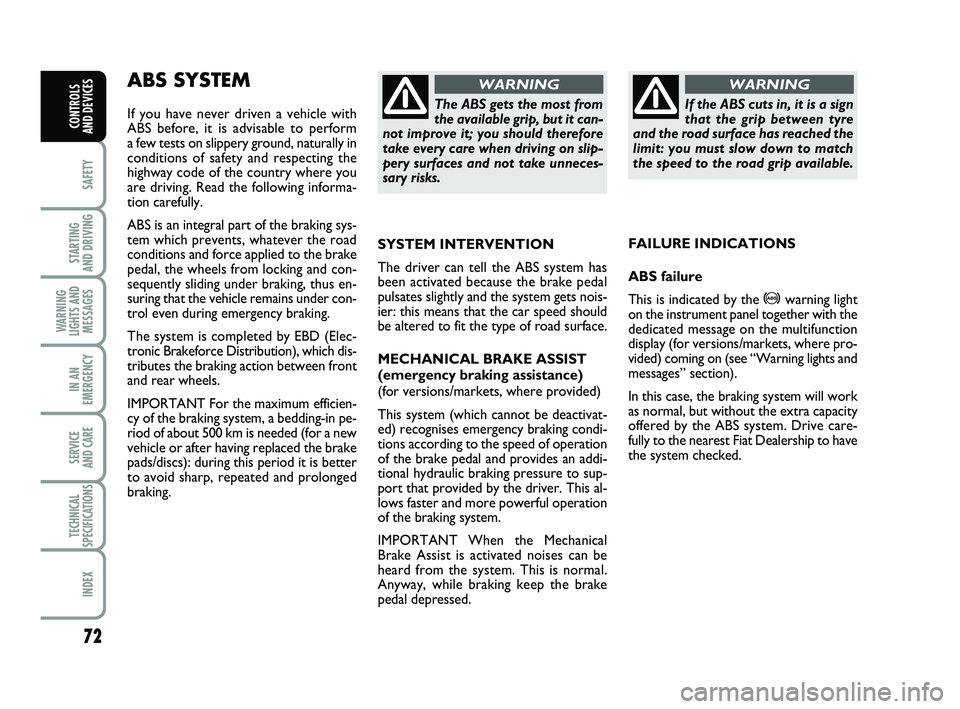
72
SAFETY
STARTING
AND DRIVING
WARNING
LIGHTS AND MESSAGES
IN AN
EMERGENCY
SERVICE
AND CARE
TECHNICAL
SPECIFICATIONS
INDEX
CONTROLS
AND DEVICES
ABS SYSTEM
If you have never driven a vehicle with
ABS before, it is advisable to perform
a few tests on slippery ground, naturally in
conditions of safety and respecting the
highway code of the country where you
are driving. Read the following informa-
tion carefully.
ABS is an integral part of the braking sys-
tem which prevents, whatever the road
conditions and force applied to the brake
pedal, the wheels from locking and con-
sequently sliding under braking, thus en-
suring that the vehicle remains under con-
trol even during emergency braking.
The system is completed by EBD (Elec-
tronic Brakeforce Distribution), which dis-
tributes the braking action between front
and rear wheels.
IMPORTANT For the maximum efficien-
cy of the braking system, a bedding-in pe-
riod of about 500 km is needed (for a new
vehicle or after having replaced the brake
pads/discs): during this period it is better
to avoid sharp, repeated and prolonged
braking.The ABS gets the most from
the available grip, but it can-
not improve it; you should therefore
take every care when driving on slip-
pery surfaces and not take unneces-
sary risks.
WARNING
SYSTEM INTERVENTION
The driver can tell the ABS system has
been activated because the brake pedal
pulsates slightly and the system gets nois-
ier: this means that the car speed should
be altered to fit the type of road surface.
MECHANICAL BRAKE ASSIST
(emergency braking assistance)
(for versions/markets, where provided)
This system (which cannot be deactivat-
ed) recognises emergency braking condi-
tions according to the speed of operation
of the brake pedal and provides an addi-
tional hydraulic braking pressure to sup-
port that provided by the driver. This al-
lows faster and more powerful operation
of the braking system.
IMPORTANT When the Mechanical
Brake Assist is activated noises can be
heard from the system. This is normal.
Anyway, while braking keep the brake
pedal depressed.
If the ABS cuts in, it is a sign
that the grip between tyre
and the road surface has reached the
limit: you must slow down to match
the speed to the road grip available.
WARNING
FAILURE INDICATIONS
ABS failure
This is indicated by the
>warning light
on the instrument panel together with the
dedicated message on the multifunction
display (for versions/markets, where pro-
vided) coming on (see “Warning lights and
messages” section).
In this case, the braking system will work
as normal, but without the extra capacity
offered by the ABS system. Drive care-
fully to the nearest Fiat Dealership to have
the system checked.
070-090 PUNTO POP 1ed EN 24/03/14 11:36 Pagina 72
Page 78 of 219
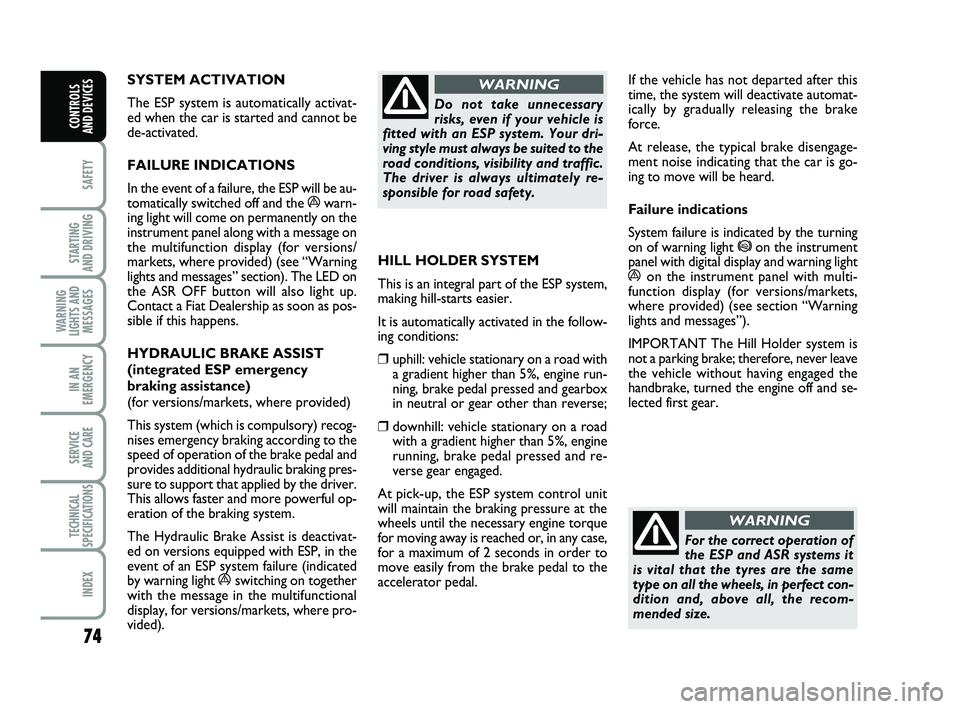
74
SAFETY
STARTING
AND DRIVING
WARNING
LIGHTS AND MESSAGES
IN AN
EMERGENCY
SERVICE
AND CARE
TECHNICAL
SPECIFICATIONS
INDEX
CONTROLS
AND DEVICES
SYSTEM ACTIVATION
The ESP system is automatically activat-
ed when the car is started and cannot be
de-activated.
FAILURE INDICATIONS
In the event of a failure, the ESP will be au-
tomatically switched off and the
áwarn-
ing light will come on permanently on the
instrument panel along with a message on
the multifunction display (for versions/
markets, where provided) (see “Warning
lights and messages” section). The LED on
the ASR OFF button will also light up.
Contact a Fiat Dealership as soon as pos-
sible if this happens.
HYDRAULIC BRAKE ASSIST
(integrated ESP emergency
braking assistance)
(for versions/markets, where provided)
This system (which is compulsory) recog-
nises emergency braking according to the
speed of operation of the brake pedal and
provides additional hydraulic braking pres-
sure to support that applied by the driver.
This allows faster and more powerful op-
eration of the braking system.
The Hydraulic Brake Assist is deactivat-
ed on versions equipped with ESP, in the
event of an ESP system failure (indicated
by warning light
áswitching on together
with the message in the multifunctional
display, for versions/markets, where pro-
vided).
Do not take unnecessary
risks, even if your vehicle is
fitted with an ESP system. Your dri-
ving style must always be suited to the
road conditions, visibility and traffic.
The driver is always ultimately re-
sponsible for road safety.
WARNING
HILL HOLDER SYSTEM
This is an integral part of the ESP system,
making hill-starts easier.
It is automatically activated in the follow-
ing conditions:
❒uphill: vehicle stationary on a road with a gradient higher than 5%, engine run-
ning, brake pedal pressed and gearbox
in neutral or gear other than reverse;
❒downhill: vehicle stationary on a roadwith a gradient higher than 5%, engine
running, brake pedal pressed and re-
verse gear engaged.
At pick-up, the ESP system control unit
will maintain the braking pressure at the
wheels until the necessary engine torque
for moving away is reached or, in any case,
for a maximum of 2 seconds in order to
move easily from the brake pedal to the
accelerator pedal. If the vehicle has not departed after this
time, the system will deactivate automat-
ically by gradually releasing the brake
force.
At release, the typical brake disengage-
ment noise indicating that the car is go-
ing to move will be heard.
Failure indications
System failure is indicated by the turning
on of warning light *
on the instrument
panel with digital display and warning light
áon the instrument panel with multi-
function display (for versions/markets,
where provided) (see section “Warning
lights and messages”).
IMPORTANT The Hill Holder system is
not a parking brake; therefore, never leave
the vehicle without having engaged the
handbrake, turned the engine off and se-
lected first gear.
For the correct operation of
the ESP and ASR systems it
is vital that the tyres are the same
type on all the wheels, in perfect con-
dition and, above all, the recom-
mended size.
WARNING
070-090 PUNTO POP 1ed EN 24/03/14 11:36 Pagina 74
Page 119 of 219
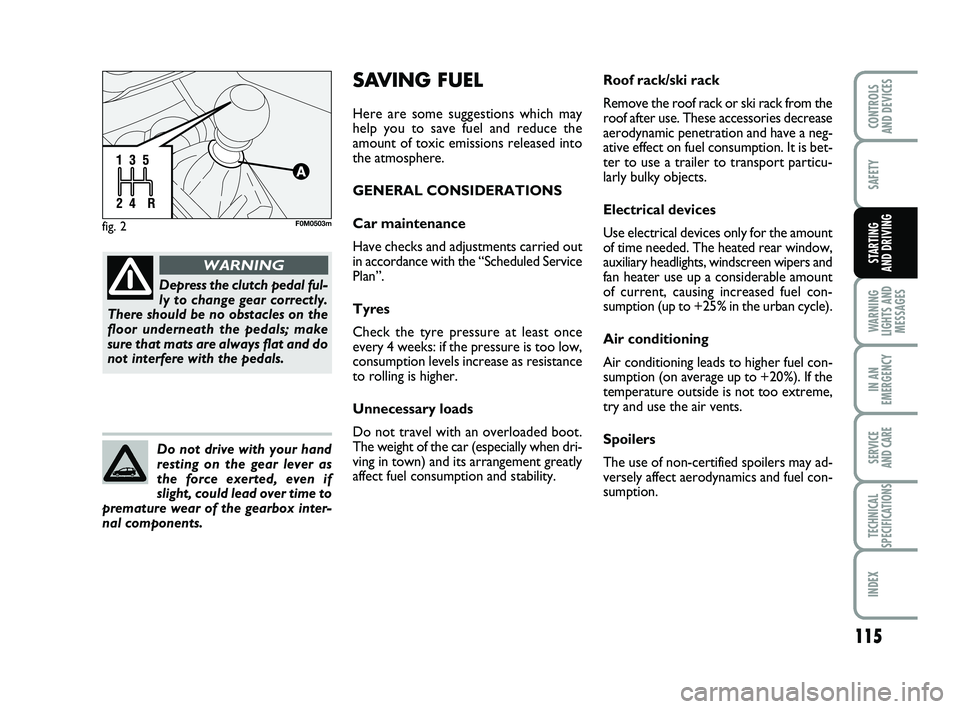
115
SAFETY
WARNING
LIGHTS AND MESSAGES
IN AN
EMERGENCY
SERVICE
AND CARE
TECHNICAL
SPECIFICATIONS
INDEX
CONTROLS
AND DEVICES
STARTING
AND DRIVING
fig. 2F0M0503m
Depress the clutch pedal ful-
ly to change gear correctly.
There should be no obstacles on the
floor underneath the pedals; make
sure that mats are always flat and do
not interfere with the pedals.
WARNING
Do not drive with your hand
resting on the gear lever as
the force exerted, even if
slight, could lead over time to
premature wear of the gearbox inter-
nal components.
Roof rack/ski rack
Remove the roof rack or ski rack from the
roof after use. These accessories decrease
aerodynamic penetration and have a neg-
ative effect on fuel consumption. It is bet-
ter to use a trailer to transport particu-
larly bulky objects.
Electrical devices
Use electrical devices only for the amount
of time needed. The heated rear window,
auxiliary headlights, windscreen wipers and
fan heater use up a considerable amount
of current, causing increased fuel con-
sumption (up to +25% in the urban cycle).
Air conditioning
Air conditioning leads to higher fuel con-
sumption (on average up to +20%). If the
temperature outside is not too extreme,
try and use the air vents.
Spoilers
The use of non-certified spoilers may ad-
versely affect aerodynamics and fuel con-
sumption.SAVING FUEL
Here are some suggestions which may
help you to save fuel and reduce the
amount of toxic emissions released into
the atmosphere.
GENERAL CONSIDERATIONS
Car maintenance
Have checks and adjustments carried out
in accordance with the “Scheduled Service
Plan”.
Tyres
Check the tyre pressure at least once
every 4 weeks: if the pressure is too low,
consumption levels increase as resistance
to rolling is higher.
Unnecessary loads
Do not travel with an overloaded boot.
The weight of the car (especially when dri-
ving in town) and its arrangement greatly
affect fuel consumption and stability.
111-120 PUNTO POP 1ed EN 24/09/13 14.29 Pagina 115
Page 123 of 219
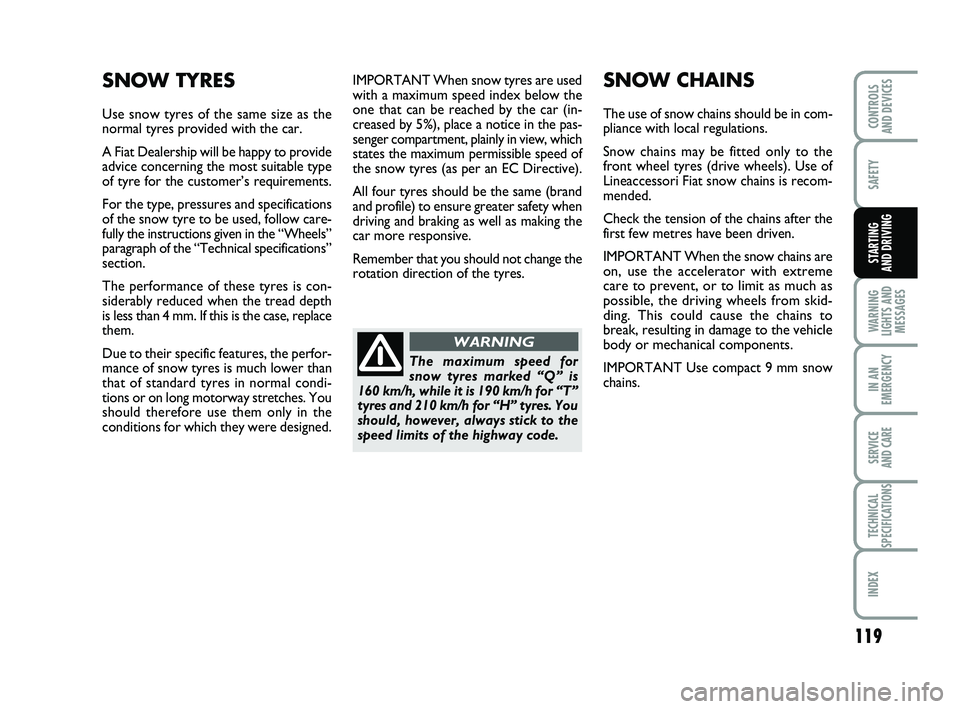
119
SAFETY
WARNING
LIGHTS AND MESSAGES
IN AN
EMERGENCY
SERVICE
AND CARE
TECHNICAL
SPECIFICATIONS
INDEX
CONTROLS
AND DEVICES
STARTING
AND DRIVING
IMPORTANT When snow tyres are used
with a maximum speed index below the
one that can be reached by the car (in-
creased by 5%), place a notice in the pas-
senger compartment, plainly in view, which
states the maximum permissible speed of
the snow tyres (as per an EC Directive).
All four tyres should be the same (brand
and profile) to ensure greater safety when
driving and braking as well as making the
car more responsive.
Remember that you should not change the
rotation direction of the tyres.SNOW CHAINS
The use of snow chains should be in com-
pliance with local regulations.
Snow chains may be fitted only to the
front wheel tyres (drive wheels). Use of
Lineaccessori Fiat snow chains is recom-
mended.
Check the tension of the chains after the
first few metres have been driven.
IMPORTANT When the snow chains are
on, use the accelerator with extreme
care to prevent, or to limit as much as
possible, the driving wheels from skid-
ding. This could cause the chains to
break, resulting in damage to the vehicle
body or mechanical components.
IMPORTANT Use compact 9 mm snow
chains.
SNOW TYRES
Use snow tyres of the same size as the
normal tyres provided with the car.
A Fiat Dealership will be happy to provide
advice concerning the most suitable type
of tyre for the customer’s requirements.
For the type, pressures and specifications
of the snow tyre to be used, follow care-
fully the instructions given in the “Wheels”
paragraph of the “Technical specifications”
section.
The performance of these tyres is con-
siderably reduced when the tread depth
is less than 4 mm. If this is the case, replace
them.
Due to their specific features, the perfor-
mance of snow tyres is much lower than
that of standard tyres in normal condi-
tions or on long motorway stretches. You
should therefore use them only in the
conditions for which they were designed.
The maximum speed for
snow tyres marked “Q” is
160 km/h, while it is 190 km/h for “T”
tyres and 210 km/h for “H” tyres. You
should, however, always stick to the
speed limits of the highway code.
WARNING
111-120 PUNTO POP 1ed EN 24/09/13 14.29 Pagina 119
Page 124 of 219
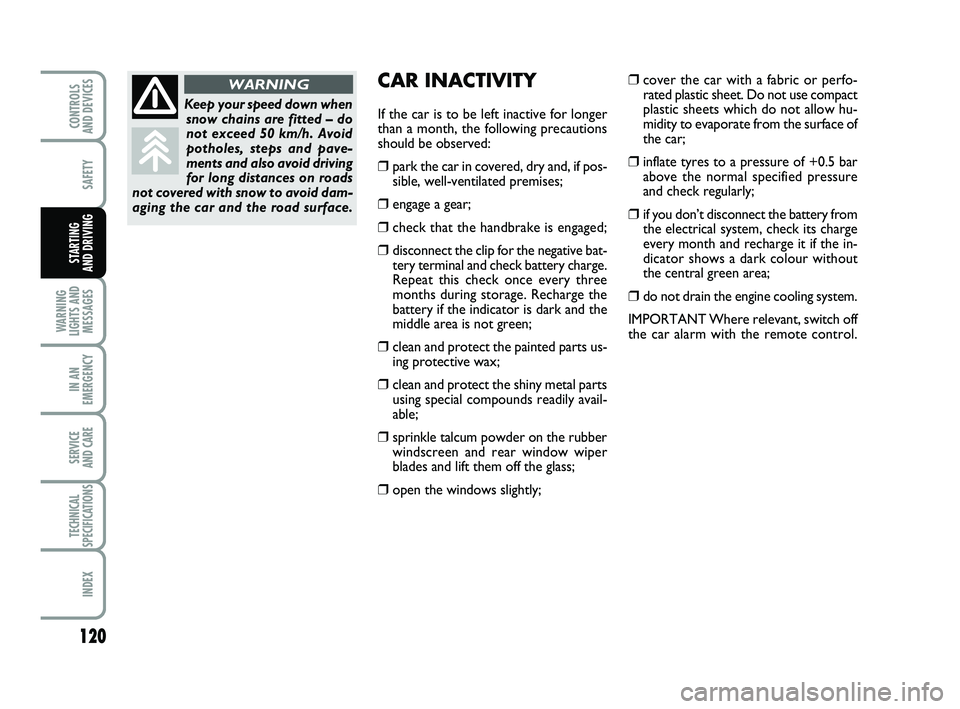
120
SAFETY
WARNING
LIGHTS AND MESSAGES
IN AN
EMERGENCY
SERVICE
AND CARE
TECHNICAL
SPECIFICATIONS
INDEX
CONTROLS
AND DEVICES
STARTING
AND DRIVING
CAR INACTIVITY
If the car is to be left inactive for longer
than a month, the following precautions
should be observed:
❒park the car in covered, dry and, if pos- sible, well-ventilated premises;
❒engage a gear;
❒check that the handbrake is engaged;
❒disconnect the clip for the negative bat-tery terminal and check battery charge.
Repeat this check once every three
months during storage. Recharge the
battery if the indicator is dark and the
middle area is not green;
❒clean and protect the painted parts us-ing protective wax;
❒clean and protect the shiny metal partsusing special compounds readily avail-
able;
❒sprinkle talcum powder on the rubberwindscreen and rear window wiper
blades and lift them off the glass;
❒open the windows slightly;
❒cover the car with a fabric or perfo-rated plastic sheet. Do not use compact
plastic sheets which do not allow hu-
midity to evaporate from the surface of
the car;
❒inflate tyres to a pressure of +0.5 barabove the normal specified pressure
and check regularly;
❒if you don’t disconnect the battery fromthe electrical system, check its charge
every month and recharge it if the in-
dicator shows a dark colour without
the central green area;
❒do not drain the engine cooling system.
IMPORTANT Where relevant, switch off
the car alarm with the remote control.
Keep your speed down when snow chains are fitted – do
not exceed 50 km/h. Avoid
potholes, steps and pave-
ments and also avoid driving
for long distances on roads
not covered with snow to avoid dam-
aging the car and the road surface.
WARNING
111-120 PUNTO POP 1ed EN 24/09/13 14.29 Pagina 120
Page 140 of 219
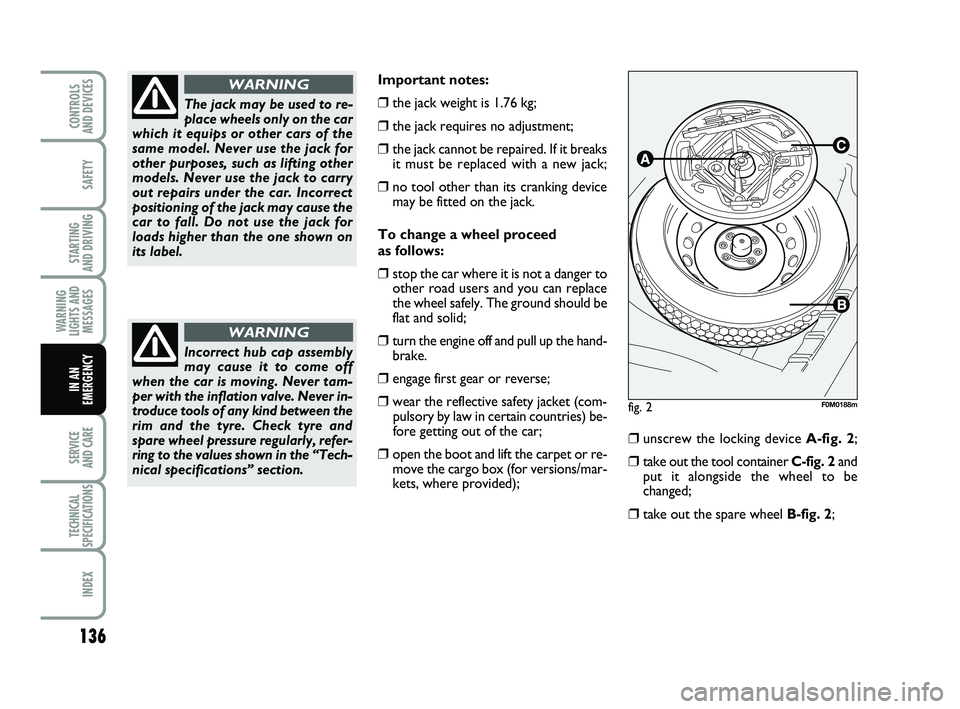
136
SAFETY
STARTING
AND DRIVING
WARNING
LIGHTS AND MESSAGES
SERVICE
AND CARE
TECHNICAL
SPECIFICATIONS
INDEX
CONTROLS
AND DEVICES
IN AN
EMERGENCY
Important notes:
❒the jack weight is 1.76 kg;
❒the jack requires no adjustment;
❒the jack cannot be repaired. If it breaks it must be replaced with a new jack;
❒no tool other than its cranking devicemay be fitted on the jack.
To change a wheel proceed
as follows:
❒stop the car where it is not a danger to other road users and you can replace
the wheel safely. The ground should be
flat and solid;
❒turn the engine off and pull up the hand-brake.
❒engage first gear or reverse;
❒ wear the reflective safety jacket (com- pulsory by law in certain countries) be-
fore getting out of the car;
❒open the boot and lift the carpet or re-
move the cargo box (for versions/mar-
kets, where provided);
❒unscrew the locking device A-fig. 2;
❒take out the tool container C-fig. 2 and
put it alongside the wheel to be
changed;
❒take out the spare wheel B-fig. 2;
fig. 2F0M0188m
The jack may be used to re-
place wheels only on the car
which it equips or other cars of the
same model. Never use the jack for
other purposes, such as lifting other
models. Never use the jack to carry
out repairs under the car. Incorrect
positioning of the jack may cause the
car to fall. Do not use the jack for
loads higher than the one shown on
its label.
WARNING
Incorrect hub cap assembly
may cause it to come off
when the car is moving. Never tam-
per with the inflation valve. Never in-
troduce tools of any kind between the
rim and the tyre. Check tyre and
spare wheel pressure regularly, refer-
ring to the values shown in the “Tech-
nical specifications” section.
WARNING
133-164 PUNTO POP 1ed EN 24/03/14 13:05 Pagina 136
Page 147 of 219
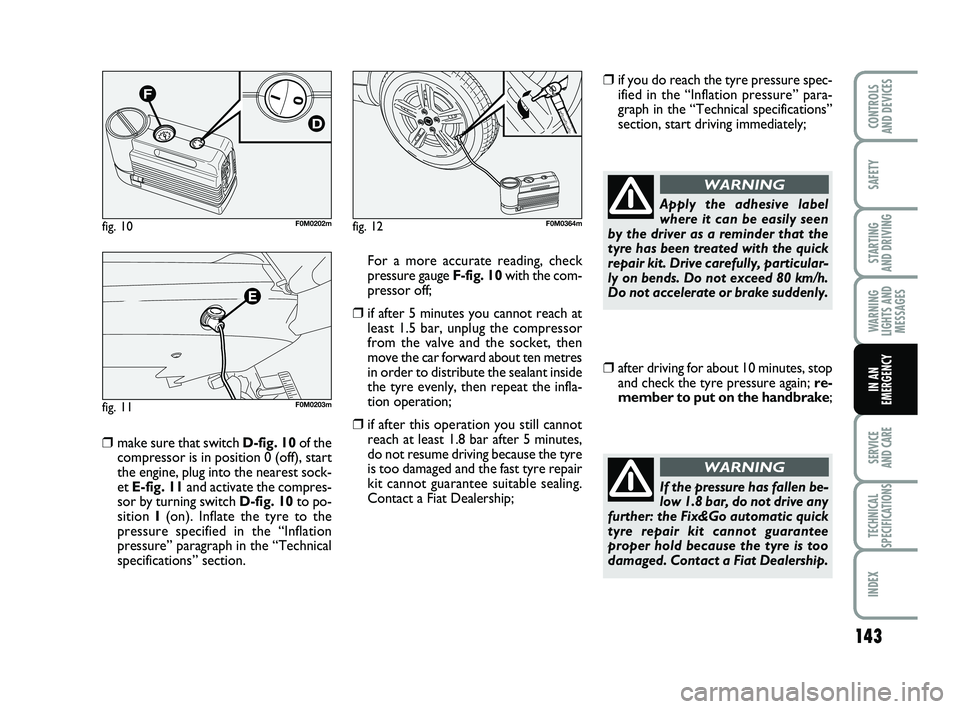
143
SAFETY
STARTING
AND DRIVING
WARNING
LIGHTS AND MESSAGES
SERVICE
AND CARE
TECHNICAL
SPECIFICATIONS
INDEX
CONTROLS
AND DEVICES
IN AN
EMERGENCY
❒ make sure that switch D-fig. 10 of the
compressor is in position 0 (off), start
the engine, plug into the nearest sock-
et E-fig. 11 and activate the compres-
sor by turning switch D-fig. 10to po-
sition I(on). Inflate the tyre to the
pressure specified in the “Inflation
pressure” paragraph in the “Technical
specifications” section. For a more accurate reading, check
pressure gauge F-fig. 10
with the com-
pressor off;
❒if after 5 minutes you cannot reach at least 1.5 bar, unplug the compressor
from the valve and the socket, then
move the car forward about ten metres
in order to distribute the sealant inside
the tyre evenly, then repeat the infla-
tion operation;
❒if after this operation you still cannotreach at least 1.8 bar after 5 minutes,
do not resume driving because the tyre
is too damaged and the fast tyre repair
kit cannot guarantee suitable sealing.
Contact a Fiat Dealership;
❒if you do reach the tyre pressure spec-ified in the “Inflation pressure” para-
graph in the “Technical specifications”
section, start driving immediately;
fig. 10F0M0202m
fig. 11F0M0203m
fig. 12F0M0364m
Apply the adhesive label
where it can be easily seen
by the driver as a reminder that the
tyre has been treated with the quick
repair kit. Drive carefully, particular-
ly on bends. Do not exceed 80 km/h.
Do not accelerate or brake suddenly.
WARNING
❒after driving for about 10 minutes, stop and check the tyre pressure again; re-
member to put on the handbrake ;
If the pressure has fallen be-
low 1.8 bar, do not drive any
further: the Fix&Go automatic quick
tyre repair kit cannot guarantee
proper hold because the tyre is too
damaged. Contact a Fiat Dealership.
WARNING
133-164 PUNTO POP 1ed EN 24/03/14 13:05 Pagina 143
Page 148 of 219
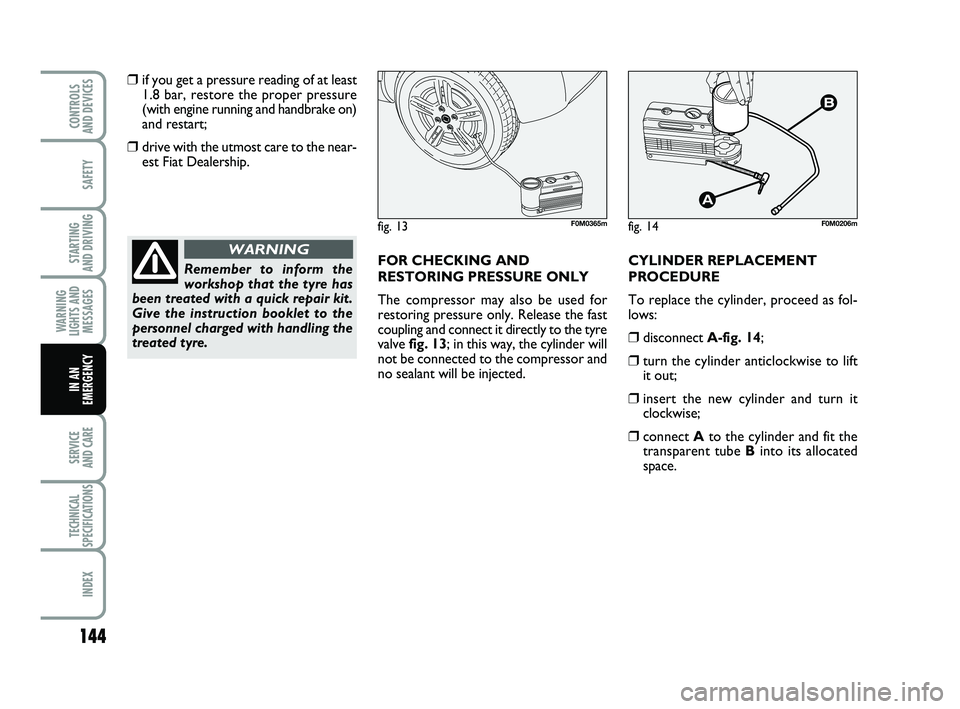
144
SAFETY
STARTING
AND DRIVING
WARNING
LIGHTS AND MESSAGES
SERVICE
AND CARE
TECHNICAL
SPECIFICATIONS
INDEX
CONTROLS
AND DEVICES
IN AN
EMERGENCY
❒if you get a pressure reading of at least 1.8 bar, restore the proper pressure
(with engine running and handbrake on)
and restart;
❒drive with the utmost care to the near-est Fiat Dealership.
FOR CHECKING AND
RESTORING PRESSURE ONLY
The compressor may also be used for
restoring pressure only. Release the fast
coupling and connect it directly to the tyre
valve fig. 13; in this way, the cylinder will
not be connected to the compressor and
no sealant will be injected. CYLINDER REPLACEMENT
PROCEDURE
To replace the cylinder, proceed as fol-
lows:
❒disconnect
A-fig. 14;
❒turn the cylinder anticlockwise to lift
it out;
❒insert the new cylinder and turn itclockwise;
❒connect Ato the cylinder and fit the
transparent tube Binto its allocated
space.
Remember to inform the
workshop that the tyre has
been treated with a quick repair kit.
Give the instruction booklet to the
personnel charged with handling the
treated tyre.
WARNING
fig. 13F0M0365mfig. 14F0M0206m
133-164 PUNTO POP 1ed EN 24/03/14 13:05 Pagina 144
Page 171 of 219
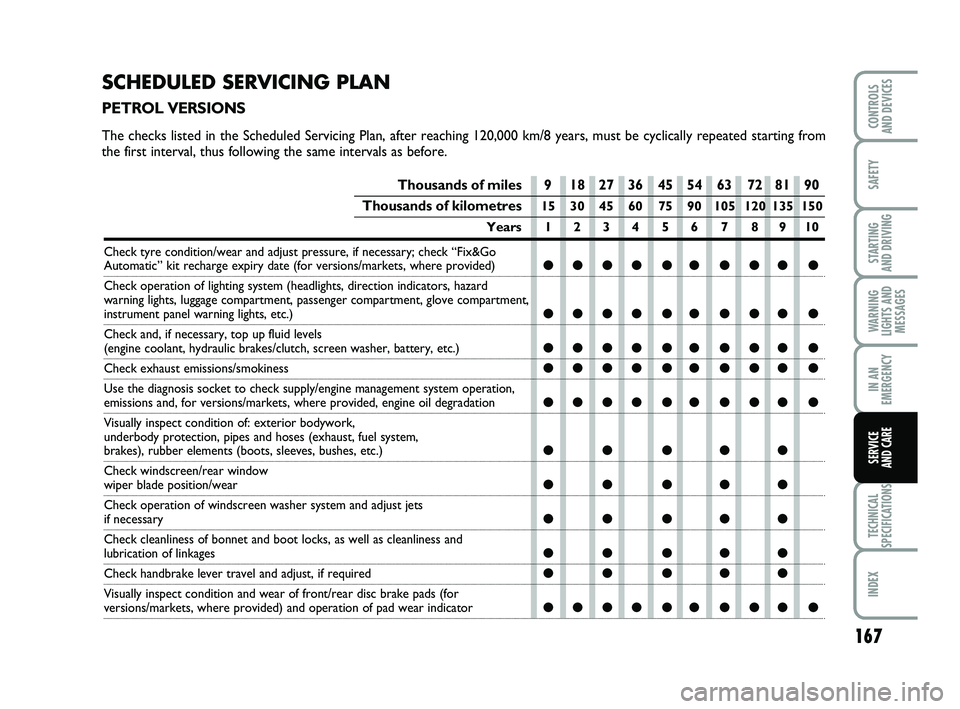
167
SAFETY
STARTING
AND DRIVING
WARNING
LIGHTS AND MESSAGES
IN AN
EMERGENCY
TECHNICAL
SPECIFICATIONS
INDEX
CONTROLS
AND DEVICES
SERVICE
AND CARE
Thousands of miles 9 18 27 36 45 54 63 72 81 90
Thousands of kilometres15 30 45 60 75 90 105 120 135 150
Years 1234 56 7 8910
Check tyre condition/wear and adjust pressure, if necessary; check “F\
ix&Go Automatic” kit recharge expiry date (for versions/markets, where pro\
vided)●●●● ●● ●●● ●
Check operation of lighting system (headlights, direction indicators, h\
azard
warning lights, luggage compartment, passenger compartment, glove compar\
tment,
instrument panel warning lights, etc.)●●●● ●● ●●● ●
Check and, if necessary, top up fluid levels (engine coolant, hydraulic brakes/clutch, screen washer, battery, etc.)\
●●●● ●● ●●● ●
Check exhaust emissions/smokiness●●●● ●● ●●● ●
Use the diagnosis socket to check supply/engine management system operat\
ion, emissions and, for versions/markets, where provided, engine oil degradat\
ion●●●● ●● ●●● ●
Visually inspect condition of: exterior bodywork,
underbody protection, pipes and hoses (exhaust, fuel system,
brakes), rubber elements (boots, sleeves, bushes, etc.)●● ●●●
Check windscreen/rear window wiper blade position/wear●● ●●●
Check operation of windscreen washer system and adjust jets if necessary●● ●●●
Check cleanliness of bonnet and boot locks, as well as cleanliness and lubrication of linkages●● ●●●
Check handbrake lever travel and adjust, if required●● ●●●
Visually inspect condition and wear of front/rear disc brake pads (for \
versions/markets, where provided) and operation of pad wear indicator●●●● ●● ●●● ●
SCHEDULED SERVICING PLAN
PETROL VERSIONS
The checks listed in the Scheduled Servicing Plan, after reaching 120,00\
0 km/8 years, must be cyclically repeated starting from
the first interval, thus following the same intervals as before.
165-184 PUNTO POP 1ed EN 07/04/14 09:35 Pagina 167
Page 173 of 219
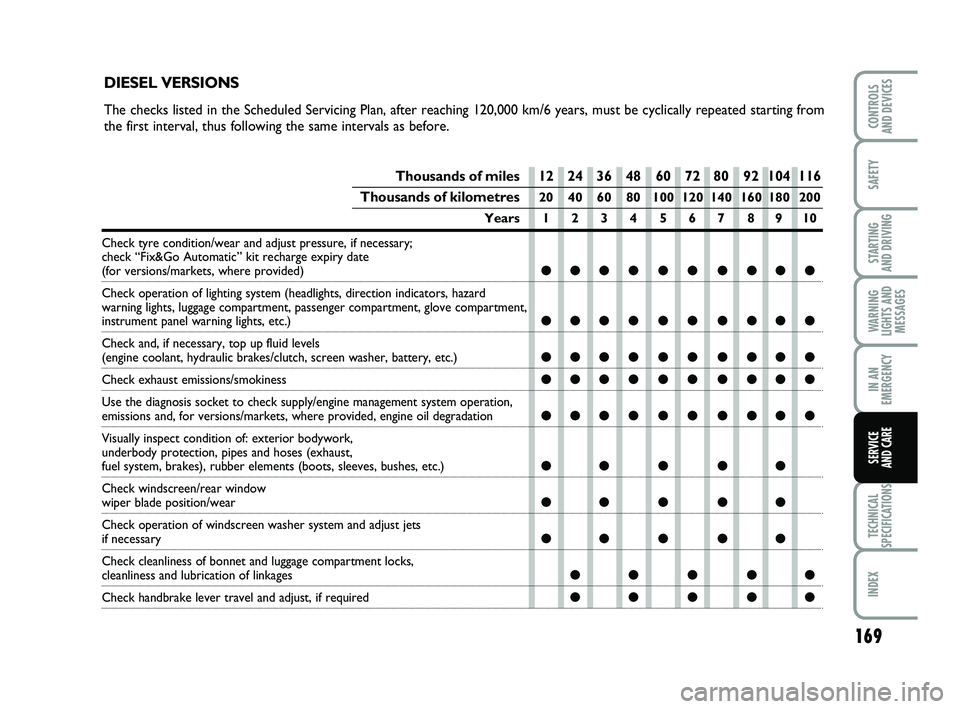
169
SAFETY
STARTING
AND DRIVING
WARNING
LIGHTS AND MESSAGES
IN AN
EMERGENCY
TECHNICAL
SPECIFICATIONS
INDEX
CONTROLS
AND DEVICES
SERVICE
AND CARE
Thousands of miles 12 24 36 48 60 72 80 92 104 116
Thousands of kilometres20 40 60 80 100 120 140 160 180 200
Years 1234 567 8910
Check tyre condition/wear and adjust pressure, if necessary;
check “Fix&Go Automatic” kit recharge expiry date
(for versions/markets, where provided)●●●● ●● ●●●●
Check operation of lighting system (headlights, direction indicators, h\
azard
warning lights, luggage compartment, passenger compartment, glove compar\
tment,
instrument panel warning lights, etc.)●●●● ●● ●●●●
Check and, if necessary, top up fluid levels (engine coolant, hydraulic brakes/clutch, screen washer, battery, etc.)\
●●●● ●● ●●●●
Check exhaust emissions/smokiness●●●● ●● ●●●●
Use the diagnosis socket to check supply/engine management system operat\
ion, emissions and, for versions/markets, where provided, engine oil degradat\
ion●●●● ●● ●●●●
Visually inspect condition of: exterior bodywork,
underbody protection, pipes and hoses (exhaust,
fuel system, brakes), rubber elements (boots, sleeves, bushes, etc.)●●●●●
Check windscreen/rear window wiper blade position/wear●●●●●
Check operation of windscreen washer system and adjust jets if necessary●●●●●
Check cleanliness of bonnet and luggage compartment locks, cleanliness and lubrication of linkages●● ● ●●
Check handbrake lever travel and adjust, if required●● ● ●●
DIESEL VERSIONS
The checks listed in the Scheduled Servicing Plan, after reaching 120,00\
0 km/6 years, must be cyclically repeated starting from
the first interval, thus following the same intervals as before.
165-184 PUNTO POP 1ed EN 07/04/14 09:35 Pagina 169